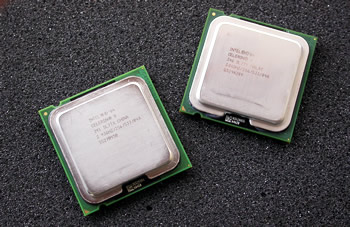1. Introduction

Intel is one the major CPU manufacturers worldwide. Today, Intel supplies the
computing and communications industries with chips, boards, systems and software
building blocks that are the "ingredients" of computer systems, servers, networking
and communications products.
We recently received from Intel, two Celeron
processors from the D series, the 341 and 346 models, running at 2.93 GHz and
3.06 GHz respectively. The Celeron D series, according to the manufacturer,
delivers a balanced level of proven technology and exceptional value for desktop
PCs. It concerns an affordable solution of processors coupled with decent
performance.
Specifications for our two Celeron D processors can be found in the table below:
| Processor |
Intel Celeron D Processor |
| Processor Number |
341 |
346 |
| Architecture |
90 nm process technology |
| L2 Cache |
256KB |
| Clock Speed |
2.93 GHz |
3.06 GHz |
| Front Side Bus |
533 MHz |
| Socket |
775 |
| Intel Extended Memory 64 Technology |
Yes |
| Execute Disable Bit |
Yes |
| Features |
- Data Flow Analysis
- Speculative Execution
- Non-Blocking Level 1 Cache
- Streaming SIMD Extensions 3
- Dual Independent Bus (DIB) |
Architecture
The size and spacing of the processors's transistors (silicon etchings), which
partially determine the switching speed. The diameter of transistors is measured
in microns. One micron is one-millionth of a meter. The 90 nm (a nanometer is
one-billionth of a meter) process combines higher-performance, lower-power transistors,
strained silicon, high-speed copper interconnects and a new low-k dielectric
material.
Clock Speed
The speed at which the processor executes instructions. Every processor contains
an internal clock that regulates the rate at which instructions are executed.
It is expressed in Megahertz (MHz), which is 1 million cycles per second or
Gigahertz (GHz), which is 1 billion cycles per second.
Front Side Bus
The speed of the bus that connects the processor to main memory (RAM). As processors
have become faster and faster, the system bus has become one of the chief bottlenecks
in modern PCs. Typical bus speeds are 400 MHz, 533 MHz, 667 MHz, and 800 MHz.
L2 Cache
The size of 2nd level cache. L2 Cache is ultra-fast memory that buffers information
being transferred between the processor and the slower RAM in an attempt to
speed these types of transfers.
EM64T
Intel Extended Memory 64 Technology (Intel EM64T) is an enhancement to Intel's
IA-32 architecture. The enhancement allows the processor to run newly written
64-bit code and access larger amounts of memory.
Execute Disable Bit
Can improve protection against malicious "buffer overflow" attacks
when properly enabled with a supporting operating system.
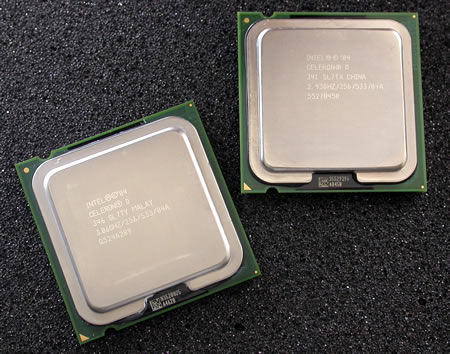


As you may have noticed, Intel manufactures its processors in many different
asian countries. Our samples were from China and Malaysia.
The retail box includes the CPU, cooling system, warranty and installation manual.

The stock cooling system :

The base is made of aluminium. Other Intel processors we have reviewed have had a copper base.

Removing the fan to reveal the heatsink, shows that the base the fan sits on,
is solid aluminum.

In this review, we will compare the two Celeron D processors and put them up
against the P4 530 and AMD Athlon 64 3000+.
2. Test System - Configuration
Here's a rundown of our testbed, used to test the Intel Celeron D 341 and 346
processors:
System Specifications:
CPU: Intel Celeron D 341 and 346
Cooler: Thermaltake Blue Orb II and stock
Case: Antec
Motherboard: Asus P5N32-SLI Deluxe
Power supply: Thermaltake PurePower 520W
Memory: 2X512MB OCZ DDR2 PC2-5400 (dual channel)
VGA: AOpen Aeolus 6800Ultra PCI-E
Hard Disk Drive: WD800JD 80GB 7200RPM
OS: Windows XP Pro SP2
Drivers: 77.77
DirectX: v9.0c
The 341 runs by default at 2.93GHz with the multiplier preset at 22, while the 346 at 3.06GHz with multiplier at 23.
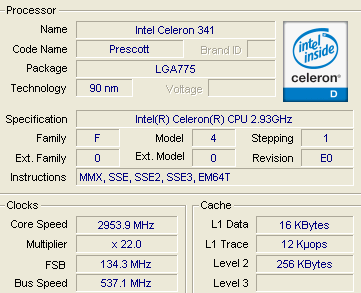

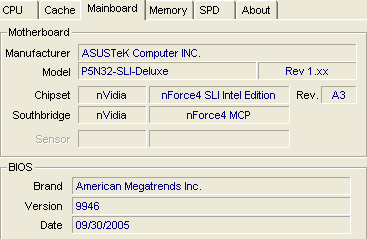
Benchmarks & Applications used
- Sisoft Sandra 2005
- Prime95
- PCMark04
- PCMark05
- 3DMark01
- 3DMark03
- 3DMark05
- PassMark Performance Test V5.0
- Half Life 2 - VST
- Doom 3
- FlaskMPEG
- DVD Shrink
- dBPower
- WinRAR
- CPU-Z
- SpeedFan
3. SiSoftware Sandra 2005
SiSoftware Sandra is a 32-bit and 64-bit Windows system analyser that includes benchmarking, testing and listing modules. It also provides information about the CPU, chipset, video adapter, ports, printers, sound card, memory, network, Windows internals, AGP, ODBC Connections, USB2, Firewire, etc.
The CPU Arithmetic benchmark tests how your CPU stacks up against other typical combinations:
Multi-Processor (SMP) support for up to 32/64 CPUs & SMT
- Test takes about 20/30 seconds on P6-class PCs
- Test is repeated 3 to 5 times to get a realistic result
- Results outside the confidence limits (5%) are discarded
- Command Line Switch: CPUAABench
- Requirements: None
- OS (Win32) Support: Windows 2000, XP, 2003
- OS (Win32 CE) Support: PocketPC 2000/2002/2003, SmartPhone 2002, 2003
- OS (Win64) Support: Windows XP/2003
Sandra's CPU arithmetic benchmark suite uses 2 famous benchmarks (Dhrystone and Whetstone) for stress testing the processor. Also, it includes a new version of the Whetstone test that makes use of a processor's SSE2 instructions to show the performance boost an application might gain should it be optimized for SSE2. Unfortunately, this does not always represent true real-life performance, but is useful for comparing the speed of various CPUs.
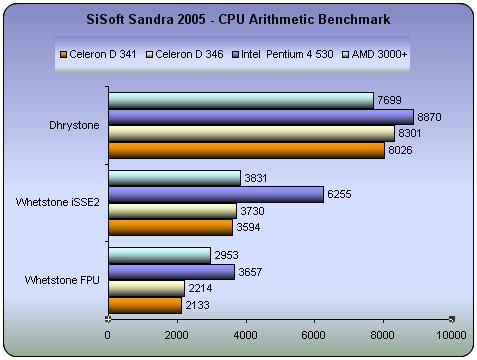
The P4 leads the race in all tests. The AMD is better with Whetstone while
with both Dhrystones, the Celerons reported a higher score.
The CPU Multi-Media benchmark tests how your CPU stacks up against other typical combinations:
- Multi-Processor (SMP) support for up to 32/64 CPUs & SMT.
- Test takes about 20 seconds on P6-class PCs.
- Test is repeated 3 to 5 times to get a realistic result.
- Results outside the confidence limits (5%) are discarded.
- Command Line Switch: CPUMMBench
- Requirements: MMX (Enhanced), 3DNow! (Enhanced) or SSE(2/3) recommended
- OS (Win32) Support: Windows 2000, XP, 2003
- OS (Win64) Support: Windows XP/2003
The test has two parts:
Integer test - using integer data:
- MP SSE3 is used for better performance if supported.
- MP SSE2 is used for better performance if supported.
- MP SSE (Streaming SIMD) is used for better performance if supported.
- MP Enhanced MMX is used for better performance if supported.
- MP MMX is used for better performance if supported.
- MP ALU is used otherwise.
Floating-point test - using floating point data:
- MP SSE3 is used for better performance if supported.
- MP SSE2 is used for better performance if supported.
- MP SSE (Streaming SIMD) is used for better performance if supported.
- MP 3DNow! Enhanced is used for better performance if supported.
- MP 3DNow! is used for better performance if supported.
- MP FPU is used is used otherwise.
This test involves the generation of Mandelbrot Set fractals that are used to realistically describe and generate natural objects such as mountains or clouds. By using various multi-media extensions (MMX), 3DNow! and SSE(2/3), better performance is achieved.
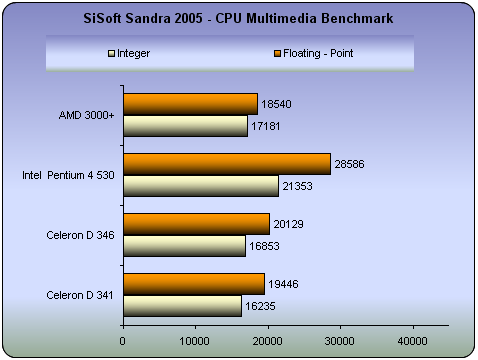
Again, the P4 processor produced the best results, especially in the floating-point
department. It is rather interesting that the Celeron processors had better
performance than the AMD processor.
4. PCMark04 - 05
PCMark04 and 2005 are application-based benchmarks and a premium tool for measuring overall PC performance. It uses portions of real applications instead of including very large applications or using specifically created code. This allows PCMark04 to be a smaller installation as well as to report very accurate results. As far as possible, PCMark04 uses public domain applications whose source code can be freely examined by any user.
Both PCMark04 and PCMark05 include 4 categorized suites for benchmarking your computer. These include CPU, Graphics, Memory and a Hard Disk Drive benchmark. In our case, we selected only the CPU test suite.

The P4 530 earned the most PCMarks while the Celeron D 346 is close behind.
The D 341 is is in third place and the AMD comes in last. As you may notice
in the following table, the P4 530 is better in almost all tests apart from
the Grammar Check and Audio Conversion where the AMD had more throughput. Other
than this, the Celeron processors reported better performance than the AMD Athlon
64 3000+ in the remaining tests. In most cases, the Celeron processors were
not that far behind the P4 processor, and in the case of File Decryption were
actually better.
The test results, analytically:
| |
341 |
346 |
530 |
3000+ |
| File Compression (MB/sec) |
3.2 |
3.3 |
4,1 |
2,6 |
| File Encryption (MB/sec) |
42.2 |
43.7 |
54,6 |
28,0 |
| File Decompression (MB/sec) |
29.4 |
30.3 |
36,5 |
22,8 |
| Image Processing (MPixels/sec) |
12.5 |
13.3 |
14,7 |
11,0 |
| Grammar Check (KB/sec) |
4.0 |
4.2 |
4,4 |
5,3 |
| File Decryption (MB/sec) |
84.5 |
87.6 |
83,4 |
55,9 |
| Audio Conversion (KB/sec) |
2251.2 |
2327.1 |
2357,7 |
2385,5 |
| WMV Video Compression (FPS) |
43.9 |
45.2 |
52,1 |
42,6 |
| DivX Video Compression (FPS) |
58.6 |
59.5 |
69,9 |
56,7 |
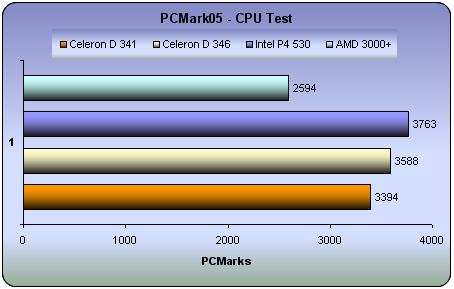
As in the case of PCMark04, the P4 is the most powerful with the Celerons close
behind.
| |
341 |
346 |
530 |
3000+ |
| File Compression (MB/sec) |
7.304 |
7.749 |
7,85 |
6,91 |
| File Decompression (MB/sec) |
116.298 |
120.636 |
120,19 |
107,94 |
| File Encryption (MB/sec) |
66.923 |
69.239 |
68,9 |
34,19 |
| File Decryption (MB/sec) |
62.300 |
66.746 |
66,35 |
31,08 |
| Image Decompression (MPixels/sec) |
23.796 |
24.933 |
24,31 |
20,69 |
| Audio Compression (KB/sec) |
1903.087 |
1974.233 |
1975,89 |
2040,57 |
| Multithreaded Test 1 |
| File Compression (MB/sec) |
3.733 |
3.998 |
- |
- |
| File Encryption (MB/sec) |
33.683 |
34.946 |
- |
- |
| Multithreaded Test 2 |
| File Decompression (MB/sec) |
29.367 |
30.341 |
- |
- |
| File Decryption (MB/sec) |
15.778 |
16.830 |
- |
- |
| Audio Decompression (KB/sec) |
453.676 |
512.831 |
- |
- |
| Image Decompression (MPixels/sec) |
5.962 |
6.330 |
- |
- |
5. 3DMark Tests
3DMark is a widely used and accepted benchmark that stresses the DirectX performance of a VGA card. For testing the performance of each card, we use the 4 game benchmark available with 3DMark. The first is a DirectX 7 game, the second and the third use DirectX 8 and the last one stresses graphics in DirectX 9. A very strong point of 3DMark is that its VGA card measurement does not require a lot of CPU power. However, the software includes benchmarks for testing the performance of the CPU. This is what we have chosen here.
- 3DMark 2001
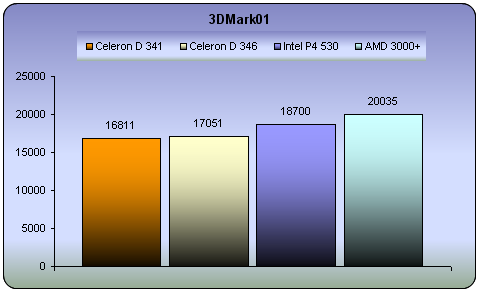
- 3DMark 2003
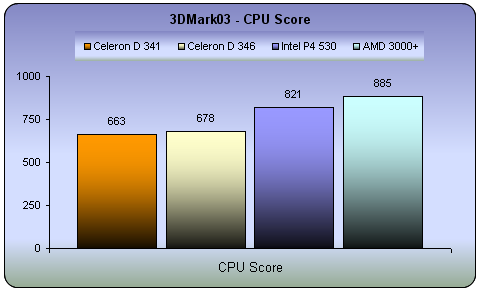
- 3DMark 2005
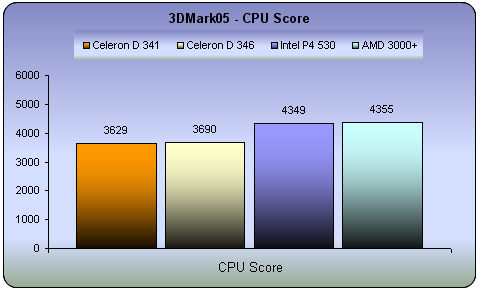
The specific tests measure the CPU performance under a graphics environment,
which is close to how games would see the CPU. In all three tests, the AMD earned
the most 3DMarks while the P4 530 follows. Lower performance from the Celeron
processors.
6. Performance Test v5.0

CPU Benchmarks
The suite of PassMark Performance Tests contains multi-process CPU tests such as:
- Integer (32-bit addition, subtraction, multiplication and division)
- Floating Point (32-bit addition, subtraction, multiplication and division)
- WIN32: MMX (matrix multiplication) or WIN64: 64bit Integer Matrix Multiplication
- WIN32: SSE (128-bit SSE operations such as addition, subtraction and multiplication) or WIN64: 64bit Floating Point Matrix operations
- WIN32: 3Dnow! (3D transformation of an array of 32-bit vertices) or WIN64: 64bit Floating Point Matrix operations
- Compression
- Encryption
- Image Rotation (Rotate image co-ordinates in memory)
- Random String Sorting
Integers are whole numbers such as 23, 459532, -26. Floating point numbers contain a fractional part, e.g. 1.003, 98394.2. These two types of numbers are treated quite differently inside a CPU, which is why PerformanceTest differentiates between the two.
For each of the integer tests, a large array of random 32 bit integers is processed using the particular mathematical operations listed below. For the floating point tests, single precision floating point numbers (32 bit) are used.
The "PassMark rating" is a weighted average of all the other test results and gives a single overall indication of the computer's performance. The bigger the number, the faster the computer. The "PassMark rating" can only be calculated if the results from all other tests are available. The value is calculated as follows.
| Test Suite |
Weighting |
| Disk |
20% |
| CD / DVD |
9% |
| Memory |
18% |
| 3D Graphics |
12% |
| 2D Graphics |
14% |
| CPU |
27% |
| Total |
100% |
In our case, we only ran the CPU test suite.
First, we chose "All" the tests for the CPU, as described above.

In the specific test, the Celeron D 346 reported slightly lower performance
than the P4 while the AMD had the lowest CPU score.
| Test |
D 341 |
D 346 |
P4 530 |
3000+ |
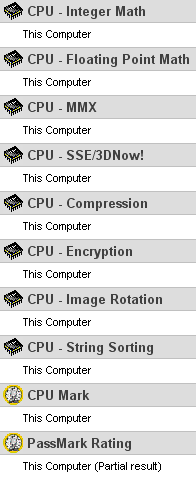 |
 |
 |
 |
 |
Multitasking Benchmarks
The Advanced Multi Process Test from the PassMark benchmark is designed to run a series of standard benchmark tests in parallel, to examine the performance under these conditions. Multiple processor machines should excel under this kind of environment, as the load is split between the various CPUs.
The tests include a number of the standard PassMark benchmarks along with some popular benchmarking algorithms and tests which emulate some day-to-day operations your CPU may be required to carry out which are particularly processor heavy.
As the tests are quite varied, as are their results, it unfortunately means that no graphing feature exists as is common amongst the other Advanced Tests. However, it is still possible to export the various results to HTML as usual.
| Test Name |
D 341 |
D 346 |
P4 530 |
3000+ |
|
| Prime Number Search |
46072 |
46819 |
45322 |
35390 |
Primes Found |
| Sorting Random Strings |
65976 |
67320 |
98977 |
84350 |
Thousand strings sorted per second |
| Compression |
191 |
198 |
212 |
144 |
KBytes per second |
| Encryption |
1099.98 |
1147.44 |
1131.97 |
673.04 |
KBytes per second |
| Rotation |
19.44 |
20.48 |
17.58 |
9.27 |
Rotation per second |
| MMX Addition |
51.78 |
53.57 |
62.82 |
47.11 |
Million Ops/Sec |
| MMX Multiplication |
48.77 |
50.28 |
61.83 |
47.31 |
Million Ops/Sec |
| Integer addition |
53.92 |
55.86 |
56.74 |
32.64 |
Million Ops/Sec |
| Whetstone |
117.65 |
122.75 |
178.27 |
150.71 |
Million Ops/Sec |
| Dhrystone |
188.09 |
197.31 |
207.99 |
178.25 |
Million Ops/Sec |
In all cases, the Celeron processors offer better performance than the AMD
3000+.
More details about each test below:
The Tests
- Prime Number Search:
This test uses a simple brute force prime number finding algorithm. It begins at 3 and checks every integer to see if it is a member of the set of primes. (A prime number is one which is divisible only by 1 and itself). The test reports the amount of primes found and the largest prime. Note that for longer test periods, the rate of Primes Per Second found will drop as the distance between primes gets larger.
- Sorting Random Strings:
The test uses qsort to continually sort 1000 strings of 256 characters. Once the test duration expires, the test reports the speed of the sorting in thousands of strings per second.
- Compression:
The Compression test uses an Adaptive encoding algorithm based on source code from Ian H. Witten, Radford M. Neal, and John G. Cleary in an article called “Arithmetic Coding for Data Compression”. The system uses a model which maintains the probability of each symbol being the next encoded. It reports a compression rate of 363% for English text, which is slightly better than the Huffman method. This test reports its results in KBytes/Sec compressed.
- Encryption:
The encryption test uses the Blowfish enciphering algorithm. It is based on the C implementation by Paul Kocher. Data is enciphered using a 16byte key in blocks of 4 KB. The test reports in KBytes/Sec.
- Rotation:
The rotation algorithm is a PassMark developed algorithm using standard rotation mathematics. The test uses a 400 x 400 pseudo image with one byte of data per pixel. The image is rotated degree by degree, with each degree counting as one rotation. The test reports in rotations per second.
- MMX Addition:
- MMX Multiplication:
These are the standard PassMark benchmarks. See MMX Tests for more information. These tests are only included with the version of PT that is for the 32-bit version of Windows.
- Maths Integer addition:
This is a standard PassMark benchmark. See Maths Tests for more information.
- Whetstone:
The Whetstone benchmark is one commonly used to test floating point arithmetic. The algorithm is based on the original C source code written by Rich Painter. The benchmark is designed to test the speed of commonly used floating point CPU instructions. The test reports in MIPS (Million Instructions Per Second.)
- Dhrystone:
The Dhrystone benchmark is one commonly used to test a machines integer arithmetic. The algorithm is based on the C source code for Dhrystone version 2 by Reinhold P. Weicker. The test reports in MIPS.
- Memory Read:
- Memory Write:
These are the standard PassMark benchmarks. See Memory Tests for more information.
- Disk Access:
This test uses the same test engine as the PassMark Advanced Disk Test. The test uses a file size of the current available RAM, a block size of 4K, the Win32 uncached interface, a 50%/50% RW level, it is 100% Sequential and executed in Synchronous mode. The test reports its results in MB/Sec.
7. Prime95
Prime95 is basically a Mersenne prime number discovery program. It's a great example of Distributed Computing, but it's most loved by overclockers for its powerful system stress-testing and benchmarking abilities. It can torture-test your CPU to produce its maximum heat or spit out any errors due to excessive overclocking. Also, using the blend test, it can consume all your physical memory and run error-checking tests on your modules to ensure their quality. However, right now, we're mostly interested in it for its benchmarking capabilities.
Here are the times for the Intel Celeron D 341 and D 346, Intel Pentium P4
530, and AMD 3000+ (less is better).

There is a huge difference between the Intel and AMD processors while there
is not much between the P4 and Celerons.
8. Encoding
Benchmarks are good for reference and comparison, but what about real life performance? For this reason, we ran some simple tests using popular utilities that most users use every day.
dBPower Tests
In the following graph, you can see how the four CPUs performed while encoding
the same audio file into different formats. For this we used a whole music CD
with a size of 750MB. We ripped the AudioCD using EAC, and then with dBPower,
we encoded from one format to another. The times needed for each task are given
below (the lower, the better of course :-).

The AMD 3800+ maintains its supremacy with WMA to MP3 conversions. In all other
tasks, the Intel CPUs were faster.
The settings for dBPower were the same for all CPUs. Analytically:

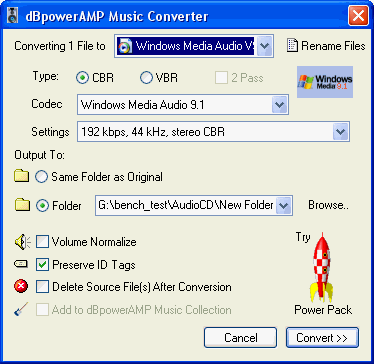
DVD Shrink Tests
Compressing a movie from DVD9 to DVD5 is a very common task. For this task we ripped an original movie (which we own of course :-), using DVD Decrypter. Then, with DVD Shrink we compressed it to fit it on a DVD5 disc. The size of the original movie was 6.85GB and we compressed it down to 4.463GB. Below you can see how many frames per second each CPU can process and the total time needed for the encoding.

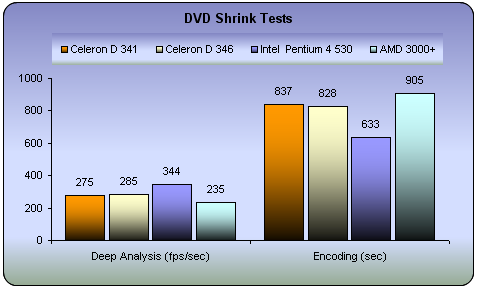
Both Intel Celeron processors can process almost the same number of frames
per second during the Deep Analysis, while the difference in encoding time between
them is only 9 seconds. The P4 530 had the best framerate during deep analysis
and fastest encoding time, with the AMD processor a good deal slower in both
cases.
DivX Tests
Another very common task is to convert a movie to the DivX format. For this we used a .vob file, sized 202MB which with FlaskMPEG was converted to .avi. The settings are given below:
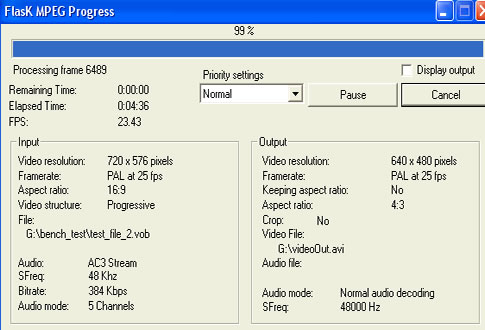

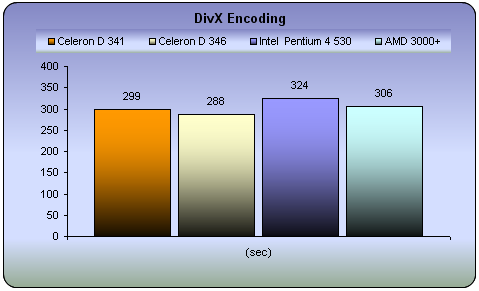
The P4 530 took the longest time while the Celeron D 346 was the fastest.
WinRAR Tests
Using a folder with 101MB of various data, we checked how much time each of the CPUs needed to compress and extract the data.
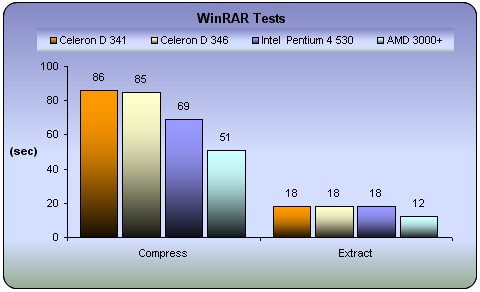
In both compression and extraction, the AMD was the fastest. There was virtually
nothing between the two Celeron processors in either case.
9. Half Life 2
Half life 2 is without doubt the most anticipated PC game of
all time.
 Physics - From pebbles to water to 2-ton trucks respond as expected, as they obey the laws of mass, friction, gravity, and buoyancy.
Physics - From pebbles to water to 2-ton trucks respond as expected, as they obey the laws of mass, friction, gravity, and buoyancy.
Graphics - Source's shader-based renderer, like the one used at Pixar to create movies such as Toy Story® and Monster's, Inc.®, creates the most beautiful and realistic environments ever seen in a video game.
AI - Neither friends nor enemies charge blindly into the fray. They can assess threats, navigate tricky terrain, and fashion weapons from whatever is at hand.
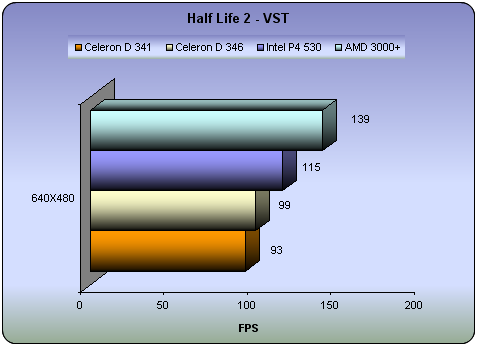
As we have seen time and time again, gaming is a field where there is no rival
for the AMD processors. The 3000+ reported around 25fps higher framerates than
the P4 530, and 40fps and more over the Celeron processors.
10. Overclocking
In order to overclock the CPU, we used the preset settings of our ASUS motherboard
and set the overclocking profile to 10%. We also tried 15% and 20% but the system
failed to boot.
- Intel Celeron D 341
 |
| The default clocks... |
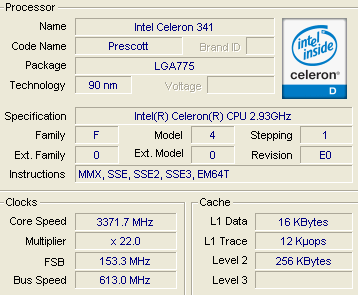 |
| Overclocked 10% |
- Intel Celeron D 346
 |
| The default clocks... |
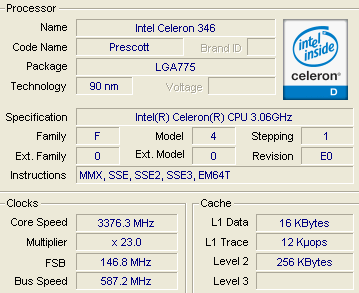 |
| Overclocked 10% |
With the new, overclocked profiles, we repeated some of the tests:
- The Tests
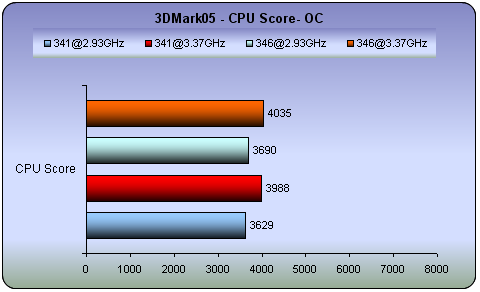
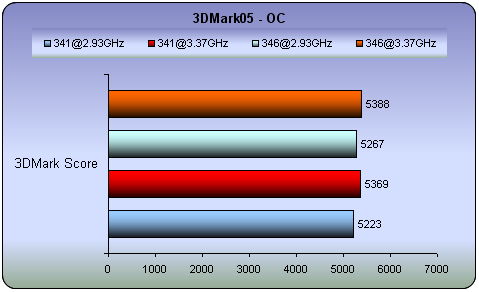
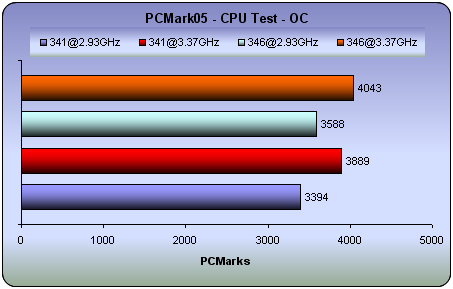
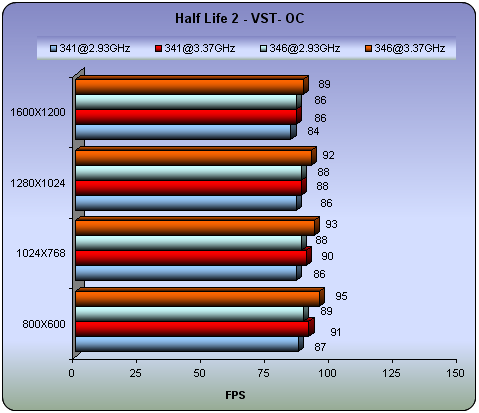
The overclocking profile increased the performance in the PCM05 and 3DM05 benchmarks
for both processors. However, in games you won't notice any marked difference
with only a 2~6fps increase.
11. Conclusion
The Celeron D series is a very attractive and affordable solution from Intel
for today's PC systems. If you don't want to pay a fortune for a system with
one of the latest P4 processors or its AMD counterpart, then the Celeron D series
is a very good alternative solution. The L2 cache is limited but you can't expect
too much in this price range. Both of the Celeron D processors we tested, reported
quite decent performance. We compared them to the cheapest Intel Pentium and
AMD Athlon 64 series, in order to see just how much of a difference there is
in performance. In almost all tests, the Celeron D processors were behind the
Intel Pentium 4 530, as we would expect. However, in comparison to the AMD Athlon
64 3000+, there were cases where the Celerons reported better results in benchmarks
such as PCMark, Passmark, Prime95 and some encoding times. However, in games
there is no comparison and the AMD outperformed all Intel processors. Of course,
this doesn't mean that you cannot play games with a Celeron.
With overclocking, don't expect too much. 10% was the limit in our. The difference
in benchmark performance was noticeable but probably not worth the effort if
you are interested in games.

The price for the Intel Celeron D 341 is close to US$75 on the e-market while
for the D 346, you'll have to pay around US$90. At the same time, the Intel
Pentium 4 530, if you can locate it, costs close to US$180, which is twice the
price of the D 346. On the other hand, the AMD Athlon 64 3000+ is a little cheaper
at US$160. As you can see, for half the money, you can have a processor running
close to 3.0 GHz without losing a lot in performance. For common, everyday tasks
and at a price that won't put a hole in your pocket, the Celeron D series is
a good choice.
